Unlocking Nature’s Rhythms for Your Aquarium.
Discover the groundbreaking Orphek iCon Lunar cycle program paired with advanced 10,000% dimming control – a true innovation in lighting. This program allows 0-100% dimming control for daytime and 0.06-1% for nighttime, creating a 24-hour full spectrum experience.
What’s Special?
We’re pioneering a real natural sun + moonlight experience, setting biological clocks for optimal aquatic health. Just as sunlight influences organisms, moonlight is equally vital for many aquatic creatures, including fish. With Moon Cycle, you’re providing the complete environmental cues organisms need for their well-being.
The secret of Atlantik ,Amazonas 960 , Osix iCon Lunar program and the most advanced 10,000% dimming control
Orphek has been over the years progressively introducing new benefits and fine tunning to your Atlantik and Atlantik Compact ,Amazonas 960 and Osix OR3 LED bars .
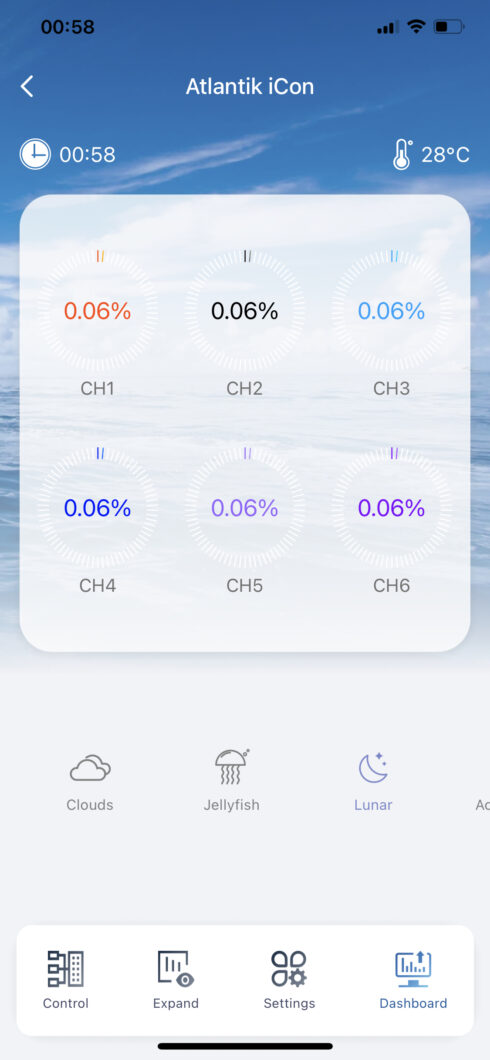
The Orphek Advanced 10,000% dimming control system
THE FINE TUNING YOU HAVE NEVER EXPECTED!
Orphek offers in iCon LED products full progressive dimming capacity in all channels.
Orphek the first and only company in the world offering 10,000% dimming control system 0-100%
for Day time and 0.06-1% for night time Moon Cycle a 24H full spectrum program.
This means that we are the only company today offering you a real natural sun + moonlight!
ORPHEK LUNAR MIMICS NATURE
Orphek iCon brings you a Lunar program that will mimic an entire natural lunar light cycle for better coral spawning.
Many coral reef animals show what is known as lunar or semi-lunar periodicity in their breeding efforts. In other words, their spawning peaks once every lunar cycle (usually at full moon) or twice every lunar cycle (at full and new moon).
So now like in Nature, you will be able to control this cycle and your corals’ spawning!!
The moonlight spectrum in a full moon
Till recently it was believed that LEDs with a maximum wavelength of 450 or 460nm were mimicking the moonlight.
Well, most advanced researches shows that moonlight offers a similar spectral profile as sunlight, but 10^6 times less intense. Meaning that the moonlight has a similar profile of wavelengths as sunlight, but a million times fewer photons per time and area. This is why you need 10,000% dimming control!
THE BIG ORPHEK SECRET!!
Corals, like terrestrial plants need a photoperiod break or rest to carry out the biological processes that are required for good healthy growth. Keeping regular moonlights of other LED solutions on throughout the night can have a negative reaction to your corals by not allowing them the rest they need. Real moonlight produces no more than 0.2 and a high of 1 Lux in tropical latitudes. There is no measurable PAR, but corals and fish do sense the light being emitted because the moon reflects about 13% of the sun’s rays. Moonlight appears blue, but there is no blue in it and this is known as the Purkinje effect.
The first thing that will come to readers minds is the lunar cycle and why this does not affect the growth of corals in the wild. The answer is that the lunar cycle consists of 14.7 days of moonlight and 14.7 days of darkness. During the moonlight phase, Lux levels vary from 0 to not more than 1 Lux.
Orphek is THE ONLY COMPANY IN THE MARKET offering the real and natural moonlight.
Contrary to other LED light brands in the market today, we took a leap into LED technology and developed our 10,000% dimming control, so our iCon LED Products with natural moonlight pass will not produce PAR to cause corals’ photosynthesis and this is really important!
The 10,000% dimming control will ensure that your corals and other photosynthetic animals get the proper rest and can process their night time biological functions (scroll down to read detail info about it).
Check here these graphs:
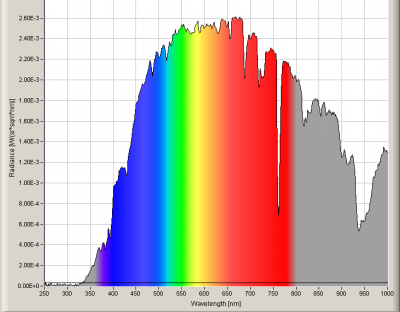
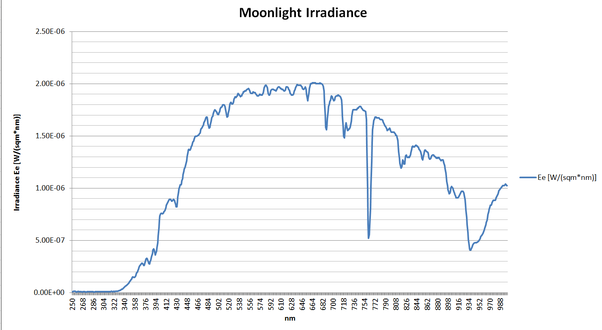
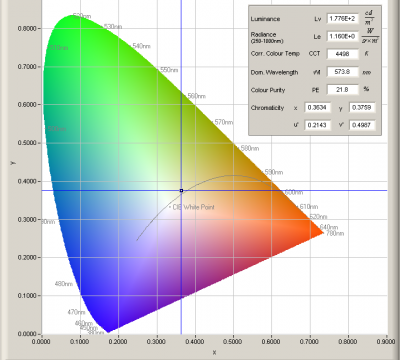
How do I find the Orphek Lunar mode?
- In Orphek App click on EXPAND.
- By clicking on Expand you will find another four cool modes: Clouds, Jellyfish, LUNAR(Moonlight) and Acclimation.
- Click on LUNAR to enter to the program setting
- Move the button to the right to enable it.
- Set both start time and end time
- Choose in which channel(s) it will run.
How do I program the LUNAR mode in my iCon app ?
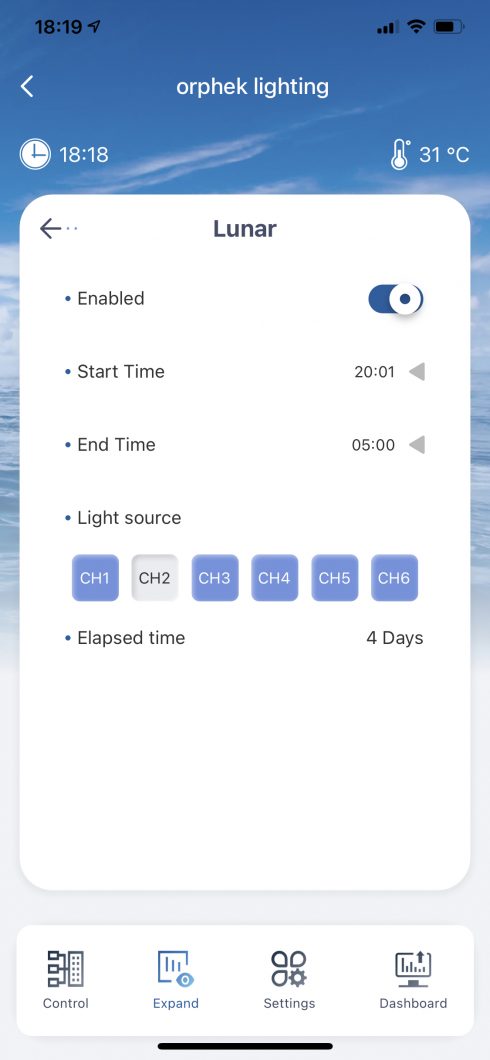
So, to program your iCon app so that your corals will benefit from moonlight all you need is to set the time to start it and the time it will stop running. Simple as that!
IMPORTANT:
- Lunar allows you to choose in which channel to run moonlight.
- Lunar program will run for one entire month.
As an example:
You can set the starting time at 20:00 p.m. at the night and 08:01a.m. to turn off the program.
In this case, the moonlight of Lunar runs both at night and in the early morning, and will last during one month period of time.
How it works?
During a month, your Atlantik iCon will start from 0% and it will continue to go up slowly, each day, by 0.067%. On the 15th day it will increase 1% reaching its peak and then, it will star to decrease slowly by 0.067% each day, to finally on the 30th day it will decrease to 0%.
If you scroll down you will find a picture of the Moon Phases. You will learn that the lunar phases gradually change during the cycle and the moonlight spectrum also changes from 0% or new moon phase, to 100% at full moon phase. The elapsed time show how many days the moonlight goes.
Important information about Moonlight, moonlight cycles and its effects on marine creatures
In this article we will also explain to you why moonlight and moonlight cycles are important to corals and marine creatures. You will also learn about biological clocks and coral reproduction (spawning).
SO let’s get to it!
Scientists and marine biologists have mostly focused on the sun light and its impact on coral reefs and marine creatures.
But today it is becoming increasingly clear to the scientific society that the moon has also influence in life, although in a more subtle way.
Life on the coral reef is not only synchronized to the 24-hour cycle of night and day and to the annual seasonal changes seen most markedly in places such as the Red Sea. The orbit of the moon is also enormously important to life in the sea. It is the moon, of course, that principally regulates the tides. As it waxes and wanes throughout the course of a lunar month, it also defines important parts of the life cycle of coral reef animals of all kinds.
How does the moon affect sea life?
In simple terms, ocean tides are caused by the gravitational pull of the moon and the sun.
Twice each month, when there is a full moon and when there is a new moon, the alignment of the moon and the sun means that their gravitational pulls are combined and produce peak tidal ranges, or “spring” tides. As well as the increased water currents found during spring tides, a full moon means that the reef will be bathed in moonlight. There are several documented cases of diurnal fish, including butterflyfish and angelfish, continuing to forage busily in these conditions.
How do moon phases and tides influence the behavior of reef animals (including fish)?
The biggest effect of the moon phase is on spawning behavior.
Many coral reef animals (including fish) show what is known as lunar or semi-lunar periodicity in their breeding efforts. In other words, their spawning peaks once every lunar cycle (usually at full moon) or twice every lunar cycle (at full and new moon).
This periodicity allows them to synchronize their behavior with other members of the same species at ideal times for the survival of their eggs and young.
As well as breeding, fish move around their habitat according to the tides.
As tides fall, smaller animals move into slightly deeper water to avoid being trapped in rock pools, which can fluctuate widely in temperature and salinity. As they move, predators often wait for them, stationed along the route that their prey take as they escape. Those animals that do survive return to their shallow feeding grounds as the tide moves back in.
Biological clocks
Most organisms possess an array of genetically encoded biological clocks that coordinate internal physiology and anticipate rhythmic changes in the environment. These clocks are wound by various environmental cues known as zeitgebers (time givers), such as light and temperature.
Sunlight is the best-studied zeitgeber, (time giver), but it turns out that for many aquatic creatures, including fish, moonlight is just as crucial.
Why the moonlight is important to corals and fish?
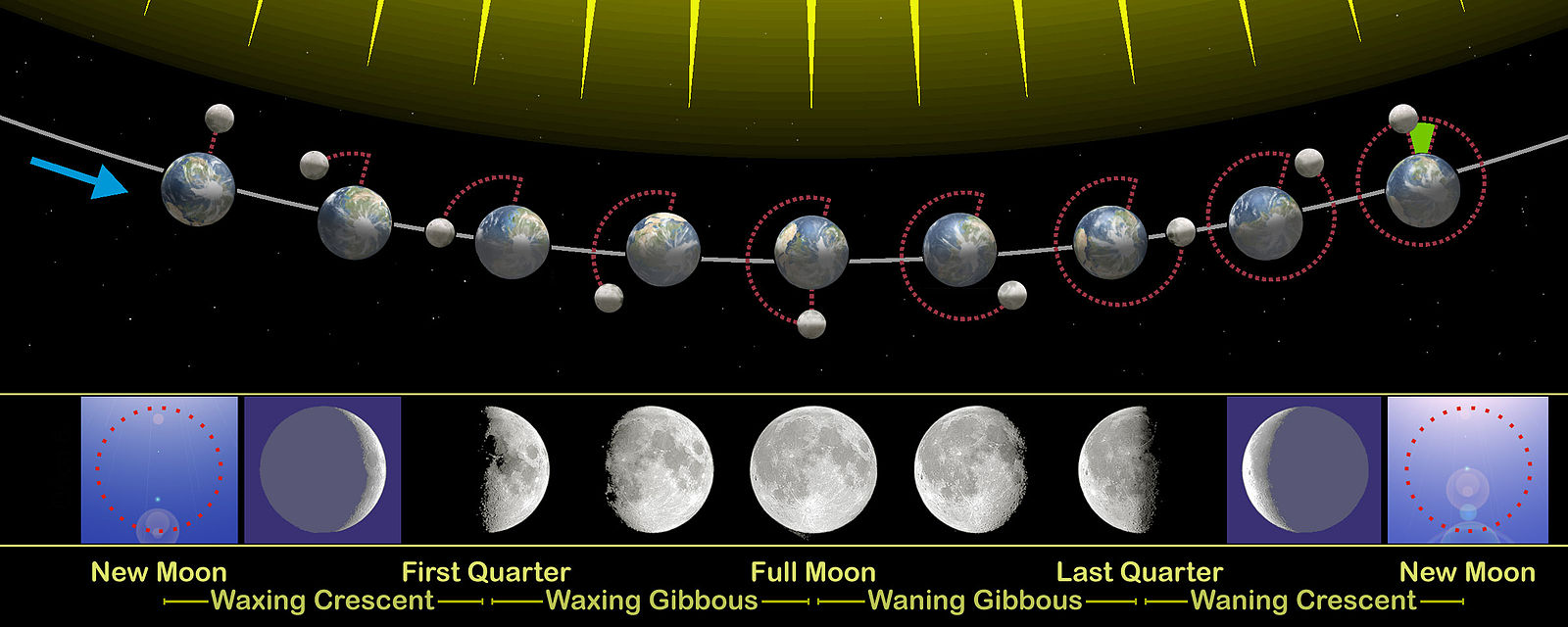
The moon is not the only environmental cue the corals use to achieve sexual synchrony on such a massive scale; water temperature and day length also matter. Yet the moon’s presence seems to be crucial. If the sky is too cloudy, and the moon obscured, the corals and fish will often not spawn. Sometimes they delay until the next full moon.
In the course of their studies, scientists revealed that not only do corals have genes that change their activity level in sync with the waxing and waning moon, regulating reproduction.
Studies also suggest that spawning timing may be driven by a light-mediated biological process which reacts to the differential shift of darkness post-twilight and pre-moonrise, and at a secondary level to changes in spectral dynamics of twilight and lunar phases.
Thus, some fish (mostly tropical fish) use moonlight-related periodicities as reliable information for synchronizing the timing of reproductive events.
Why reproduction is important to corals, fish and to us
Sexual coral reproduction, dispersal, and successful recruitment are a fundamental process on coral reefs and fish species that ensure the long-term maintenance of biodiversity.
How corals reproduce
Coral spawning is an annual event where corals simultaneously reproduce.
Why simultaneously?
During this synchronized breeding, coral polyps release millions of tiny egg and sperm bundles into the water. Each bundle must find another bundle from the same species to fertilize. So, by spawning on mass, corals increase the likelihood of finding and fertilizing a matching bundle.
Further reading/detailing fertilization
In ways that scientists still do not fully understand, mature corals release their gametes all at the same time. This synchrony is crucial, because the gametes of most coral species are viable for only a few hours. The “blizzard” makes it more likely that fertilization will occur.
The gametes, full of fatty substances called lipids, rise slowly to the ocean surface, where the process of fertilization begins. When a coral egg and sperm join together as an embryo, they develop into a coral larva, called a planula. Planulae float in the ocean, some for days and some for weeks, before dropping to the ocean floor.
Then, depending on seafloor conditions, the planulae may attach to the substrate and grow into a new coral colony at the slow rate of about .4 inches a year.
Just additional curiosity
Moonlight also drives ocean-scale mass vertical migration of zooplanktons. During Artic winters the moonlight drives the zooplankton migrations
I found this very cool but I don’t have Atlantik iCon, How to upgrade?
Interesting posts you might have missed:
- The Secret of Coral Health, Growth & Color Atlantik iCon Helius Program
- Atlantik iCon LED PCB Upgrade
- New product launch Atlantik iCon Compact Reef Aquarium LED
- New product launch Atlantik iCon Reef Aquarium LED Lighting
Orphek Acessories:
If you wish to read about/buy our Orphek AURA High End Acrylic Mounting Arms for Aquarium:
- New Orphek Product Launch – Aura Acrylic Mounting Arms
- Aura Acrylic Mounting Arms for Aquarium (Product Page)
If you wish to read about/buy our Orphek Universal Fixing Bracket Kit:
- New Orphek Product Launch – Universal Fixing Bracket Kit
- Universal Fixing Bracket Kit (Product Page)
If you wish to read about/buy our Orphek Coral Reef Aquarium Lens Kit:
- Orphek Coral Lens Kit reviews
- Review Orphek Filter Macro Corals Lens For Smartphone
- Coral Reef Aquarium Lens Kit (Product Page)
If you are a distributor, shop, online shop, Public Venue we are ready to take your order!! We have stock! Don’t miss the opportunity!
Excerpts and info for this post taken from:
Orphek Team
www. oceanservice.noaa.gov
Effects of Light Dynamics on Coral Spawning Synchrony – C. Boch, B. Ananthasubramaniam
Smithsonian: www.smithsonianmag.com/science-nature
Inducing broadcast coral spawning ex situ: Closed system mesocosm design and husbandry protocol – Jamie Craggs,James R. Guest,Michelle Davis,Jeremy Simmons,Ehsan Dashti,Michael Sweet.
The impact of Lunar Cycles on the Reef – Travis Burke.